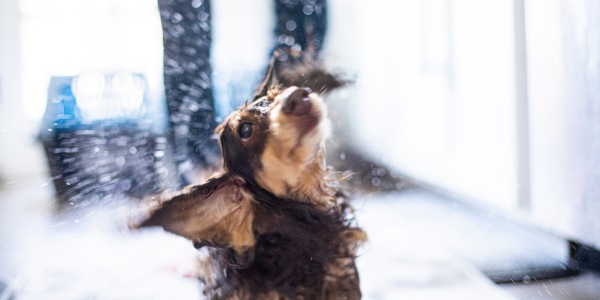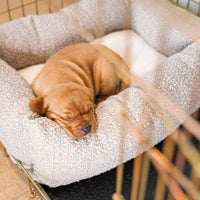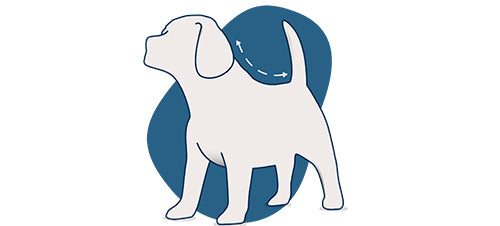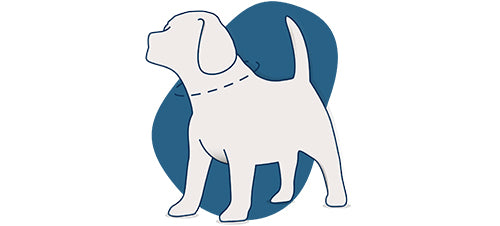If you’re anything like us you’ll want your furry friend to look their best, we know that grooming is an essential part in achieving that. Frequent dog grooming helps to keep your dog looking nice, as well as improving their overall health and wellbeing. But you may be wondering how often you should groom your dog. In this week’s blog post, we’re covering everything you need to know about dog grooming.
What Is Dog Grooming
Before we look at how often you should be grooming your dog, let’s look at what dog grooming is. If you’re a first-time dog owner or new to dog grooming we know that keeping on top of your dog’s grooming can be overwhelming which is why we’re here to help.
Dog grooming refers to maintaining your dog’s physical coat and hygiene, which includes everything you do to maintain your dog’s coat, skin, nails and ears, from bathing & brushing to cutting and clipping. For a more detail guide on ‘what dog grooming is’, check out this article from our Information Hub - it looks at everything from what is involved in dog grooming, why it’s important and how long it takes. It’s a great place to start if you’re new to dog grooming or need a refresher.
How Often Should A Dog Be Groomed
Understanding your dog’s coat type is the first step in knowing how often to groom your dog and what the best products to use are. How often to groom a dog, in our experience, will depend on things like hair length, texture, and density of your dog’s coat.
The main types of dog coats are: Short or smooth-haired, Long Haired, Double Coated, Curly and Hairless. In this guide, we break down exactly how often each type of coat needs grooming, as well as give you our top tips for looking after their coat and our favourite products.
How Often Should A Long-Haired Dog Be Groomed?

Long-Haired Dogs include breeds such as Lhasa Apso, German Shepherd, Long-Haired Chihuahuas, Dachshunds & Shih Tzus.
Long Hair coats need regular grooming to prevent matting and tangles, daily brushing will help with this and will remove any debris. If you’ve got a long-haired puppy it’s a good idea to get them used to being brushed from the day you bring them home so they’re desensitised to it from a young age.
When it comes to bathing your long-haired dog, it’s important to keep them clean but also not strip their coat from any natural oils that are keeping it shiny and healthy. In our experience bathing your long-haired dog every 6-8 weeks helps keep their coat in tip-top shape. You can either do this at home or take them to a professional groomer for a bath.
When it comes to cutting your long-haired dog it will depend on your personal taste, lifestyle and season. How short you will want to keep your long-haired dog’s coat will depend on your taste and lifestyle, the typical long-haired cuts you’ll see at Crufts are usually what is considered ‘breed standard’. But if you’re not planning on showing your dog in the show ring any time soon, maybe a shorter more practical cut might suit them more. We’d recommend visiting your groomers for a trim every 2 - 3 months, however, they will advise exactly how often they recommend for your particular lang-haired breed.
For long-haired dogs, we recommend the PetPlex Dirt Defeater collection and a slicker brush. The PetPlex Dirt Defeater collection includes a shampoo, conditioner, and cologne so is perfect for removing any tangles and keeping your dog smelling fresh.
How Often Should A Short-Haired Dog Be Groomed?

Short-Haired dogs include Beagles, Boxers, Dalmatians, Great Danes, Pugs & Rhodesian Ridgebacks.
Short-Haired dog breeds typically need less grooming than their long-haired cousins. In our experience brushing their coats once a week is plenty to help keep them healthy and free of debris.
Short-haired dogs will only need occasional baths, every 4-6 weeks or after a particularly mucky walk.
Short-haired dogs likely won’t need regular haircuts with a professional groomer, although some breeds may still need their undercoat stripped away. Contrary to popular belief, short-haired dogs can shed a lot, particularly when the seasons change. Some groomers will offer a specific short-haired dog package which will include a bath and a deshed which will help remove some of that excess hair and keep your short-haired dog’s coat in top shape.
For short-haired dogs we recommend using a gentle shampoo like the PetPlex Dirt Defeater Collection and a good brush, we like the Rosewood 2-in-1 Bath & Groom Brush as you can put shampoo in the top to dispense at bath time making grooming your dog super easy.
How Often Should A Double Coated Dog Be Groomed?

Double dog breeds include wire-haired breeds such as Border Terriers, Brussels Griffons, Jack Russel Terriers, and Schnauzers, as well as breeds such as Golden Retrievers, Labrador, Pomeranians, and Border Collies.
A double coat on a dog is simply a coat that has two layers, they have an undercoat of dense short hairs and then a top coat of longer hairs or guard hairs. The double coat is great for keeping your dog’s temperature regulated and repelling moisture and dirt.
Double-coated breeds shed a lot, especially in Spring and Fall. Although regular grooming won’t stop this it will certainly help minimise it and keep their coats looking healthy. We recommend brushing double-coated dogs 2-3 times a week - this will help remove debris, any mats or tangles, as well as help to remove some of that excess dead hair that may be irritating them.
A common misconception is that shaving your double-coated dog will help keep them cooler in the summer, however, the opposite is actually true. A double-coated dog is insulated in the follicles rather than by the hair, so when you cut their hair all the insulation is still there, and when the hair grows back quite often 10-14 hairs will grow in the place of each follicle rather than the 5-7 that was there before, which can change the texture of their hair and cause bald patches.
We recommend bathing your double-coated dog roughly every 8-12 weeks. Bathing them more frequently in the summer is a good idea as they will be shedding more and it will help to get rid of some of that excess hair.
When it comes to how often you should be taking your double-coat, it can vary depending on if they’re a short, medium, or long-haired double-coated dog but typically we’d recommend at least four times a year to help de-shed all that dead hair. Your local professional groomer will be able to advise the best length of time for your specific breed of dog.
For your double-coated dog, we recommend a good brush to help them shed that bottom coat, both a slicker brush or an undercoat rake work well.
How Often Should You Groom Your Wavy Or Curly-Haired Dog

Wavy or Curly Haired dogs include a lot of the popular poodle cross breeds such as Labradoodles, Cockapoos, Cavapoo & Cavapoochons, as well as breeds such as Bichon Frise, Spanish Waterdogs, Bedlington Terriers, and Poodles.
Although curly coat breeds are typically low shedding they still require maintenance. The curly texture can be prone to matting and tangling so daily brushing will help keep on top of this, especially after a particularly muddy or wet walk.
When it comes to bathing your curly-haired dogs, you want to avoid doing it too often so that their natural essential oils don’t get stripped from their skin and fur. On average, we recommend at most once a month but ideally every 6 weeks or so, the Dexas Mudbuster is perfect for keeping your curly-haired dog’s paws clean between baths.
Curly-haired dogs are more likely to need a regular trim than other breeds, for this, we recommend taking them to a professional groomer every 6 weeks to keep on top of it.
If you want to bathe your dog at home the PetPlex Curl Perfector Shampoo and Detangling Spray work amazingly on both curly and wavy-haired dogs. The shampoo has been specially formulated for dogs with curly coats and has added wheat protein which will strengthen your dog's hair from the root and give instant voluminous results. A detangling spray can either be used on hair wash day or to help freshen up between full grooms, and it will just help to gently tease away knots and tangles. Other grooming kit essentials for a curly-haired dog include a slicker brush and some thinning scissors to help keep the hair round their eyes neat and tidy between trims.
How Often To Groom A Hairless Dog

Hairless Dog Breeds include Chinese Crested Dogs, Hairless Chihuahuas, American Hairless Terriers, and Xoloitzcuintli.
Needless to say, hairless dogs won’t need brushing or trimming like other coat types but they will still need regular baths and it’s a good idea to brush through any patches of hair they may have. With hairless dogs typically an oily film will form after a couple of weeks, this is a good indication that they’re ready to be bathed.
We recommend a really gentle shampoo to bathe your hairless dog with, like PetPlex Derma Doctor which is fragrance-free and full of mild ingredients so it perfect for hairless dogs
How often you should groom your dog will depend on their breed and coat type. Regular grooming at home is essential for all coat types to help their coats in top shape. If you would like a little bit more information on how to groom a dog why not check out our recent Information Hub article? It’s a simple guide explaining everything you need to know to groom your dog at home.









































































































